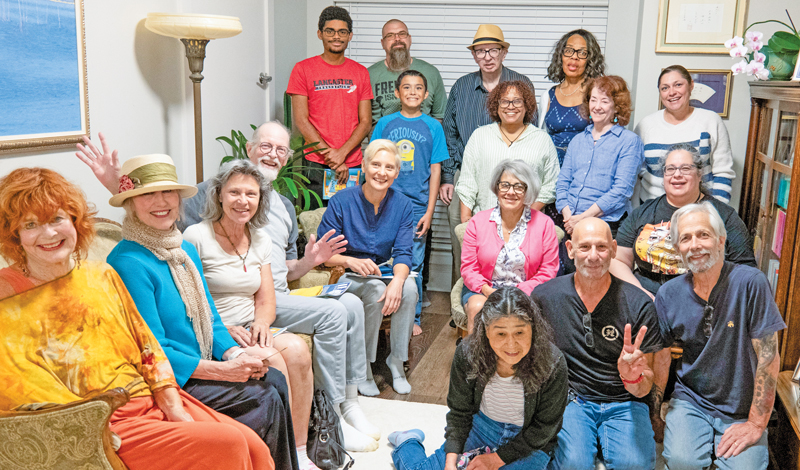Please base your monthly discussion meeting study on one of the following:
1) Buddhist Concepts (pp. 36–37)
2) Writings for Discussion Meetings (pp. 38–39)
3) Material from any recent issue of the World Tribune or Living Buddhism
Buddhist Concepts
How the Three Buddha Bodies Show Up in Our Daily Lives
Nichiren Buddhism celebrates everyone’s inherent potential for enlightenment. This means each of us can reveal our Buddha nature and live with wisdom, courage and compassion.
To illustrate this, Nichiren often referred to the concept of the “three bodies” of the Buddha: the Dharma body, the reward body and the manifested body. They represent distinct aspects of the Buddha nature we all possess.
A Brief Background
After Shakyamuni Buddha’s passing, his followers pondered the seeming contradiction between his human existence and his sublime wisdom and compassion. Early Buddhist teachers eventually addressed this by describing the Buddha as having “three bodies” (trikaya in Sanskrit): The Dharma body represented absolute truth and the eternal essence of the Buddha’s teachings; the reward body was the spiritual merits, such as great wisdom and compassion, attained through eons of bodhisattva practice; and the manifested body was the human-like form Shakyamuni assumed to teach people the way to enlightenment.
But over time, some traditions associated these three bodies with various deity-like Buddhas, implying they were separate from ordinary people and life.
Later, the Great Teacher T’ien-t’ai explained, based on the Lotus Sutra, that all three bodies are neither separate nor reserved only for divine beings. Instead, they are qualities that all people possess.
Nichiren Daishonin further taught that anyone can develop these genuine qualities and put them to use. He frequently emphasized in his writings that everyone who chants Nam-myoho-renge-kyo with sincere faith is a full-fledged Buddha, possessing unique, dignified attributes. For instance, he writes to his disciple Abutsu-bo:
You, yourself, are a Thus Come One who is originally enlightened and endowed with the three bodies. You should chant Nam-myoho-renge-kyo with this conviction. (“On the Treasure Tower,” The Writings of Nichiren Daishonin, vol. 1, pp. 299–300)
When We Chant, We Can Become Buddhas Just as We Are
So, how do these three Buddha bodies show up in our lives as we chant Nam-myoho-renge-kyo and strive for our own and others’ happiness?
The Dharma body represents the fundamental truth to which the Buddha is enlightened—the essence of ultimate reality. When we awaken to this truth within us and to our inherent enlightened nature, we can transform our lives and live with unshakable courage.
The reward body represents the Buddha’s wisdom—the inner virtues and boundless benefits, such as a free and unhindered state of life, that we gain through Buddhist practice.
The manifested body signifies the Buddha’s compassionate actions—the active expression of enlightenment in our daily lives. Through chanting Nam-myoho-renge-kyo, sharing its benefit with others and embodying its principles in our behavior, we express our Buddhahood in unique ways, bringing hope to others.
Nichiren states:
Now, when Nichiren and his followers chant Nam-myoho-renge-kyo, they are expressing joy in the fact that they will inevitably become Buddhas eternally endowed with the three bodies. (The Record of the Orally Transmitted Teachings, p. 146)
Regarding this passage, Ikeda Sensei explains:
The “three bodies” are the Buddha’s three bodies—the Dharma body, the reward body and the manifested body. Both we ourselves and others are originally Buddhas worthy of supreme respect, embodiments of the Mystic Law. This describes the Dharma body. The wisdom to create happiness for ourselves and others based on this profound awareness that we are all Buddhas corresponds to the reward body. And practical, compassionate action for the happiness of ourselves and others corresponds to the manifested body. This passage tells us that when we chant Nam-myoho-renge-kyo, we ordinary, unenlightened beings, just as we are, become Buddhas possessing these wondrous three bodies. (The Five Eternal Guidelines of the Soka Gakkai, pp. 29–30)
When we chant and work for the happiness of ourselves and others, we begin to express the three bodies of the Buddha already within us. Every action, no matter how small, can uplift and inspire those around us, creating ripples of joy and positive change that spread far and wide.
—Prepared by the SGI-USA Study Department

Writings for Discussion Meetings
Lighting the Way for Others, Lights Our Own Way
Passage
When one lights a torch for someone at night, one brings light not only to another person but to oneself as well. Likewise, when one livens other people’s complexions, one livens one’s own too, when one gives them strength, one gives oneself strength too, when one prolongs their lives, one prolongs one’s own life as well.
—“On Clothing and Food,” The Writings of Nichiren Daishonin, vol. 2, p. 1066
Background
“Be wise for your own sake. Be compassionate toward your fellow men. Build your happiness through the happiness of others.”[1] The French philosopher Voltaire captures the key to genuine happiness in these words, reflecting a universal truth: We become happy by supporting others in becoming happy too. The opposite also holds—we can never build genuine happiness on the misfortune of others.
Nichiren expresses this fundamental principle in this passage.
Although the exact date and other details of this letter are unknown, he sent it to a lay nun, expressing his appreciation for her offering of 1,000 coins.
He explains in this letter that just as lighting the way for someone at night illuminates our own path, when we support others, we, in turn, attain precious virtues and benefits.
Embracing the Daishonin’s teaching of happiness for oneself and others, SGI members treasure the people around them, discovering time and again how such actions help them grow into stronger individuals with expansive and compassionate hearts.
—Prepared by the SGI-USA Study Department
Ikeda Sensei’s Encouragement
The Spontaneous Desire to Help Others Brings Appreciation and Joy
[Nichiren] Daishonin’s declaration that “when one gives them strength, one gives oneself strength too” (WND-2, 1066) brilliantly describes how benefiting oneself and benefiting others are one and the same. With these simple words, he illustrates for us the unrivaled way of life in which benefiting oneself and benefiting others are seamlessly and naturally merged.
Here we find no egoism concerned solely with one’s own welfare while disregarding others; no narrow, self-absorbed mindset that places rigid boundaries between self and others. Duty or social propriety are not the motivators. It is a way of life that embodies compassion, the spontaneous desire to help others.
A one-sided focus on benefiting or helping others, however, can easily turn into condescension or self-sacrifice. Precisely because acting for the benefit of others also benefits ourselves, it brings us appreciation and joy.
Without seeking to escape from this suffering-filled saha world, those who strive with sincerity and wisdom, just as they are, for the welfare and happiness of others as well as themselves are living as genuine bodhisattvas. As Nichiren states in a well-known passage: “The purpose of the appearance in this world of Shakyamuni Buddha, the lord of teachings, lies in his behavior as a human being” (“The Three Kinds of Treasure,” WND-1, 852). Showing respect for all people, behavior exemplified by the Bodhisattvas of the Earth, is the true essence of the Buddha’s teaching.
In his “Guidelines for Youth,” Mr. Toda declared: “The effort to overcome the coldness and indifference in our own lives and attain the same state of compassion as the Buddha is the essence of human revolution.”[2] For us, courage takes the place of compassion. Everything starts from a courageous first step. (October 2022 Living Buddhism, p. 60)
You are reading {{ meterCount }} of {{ meterMax }} free premium articles

